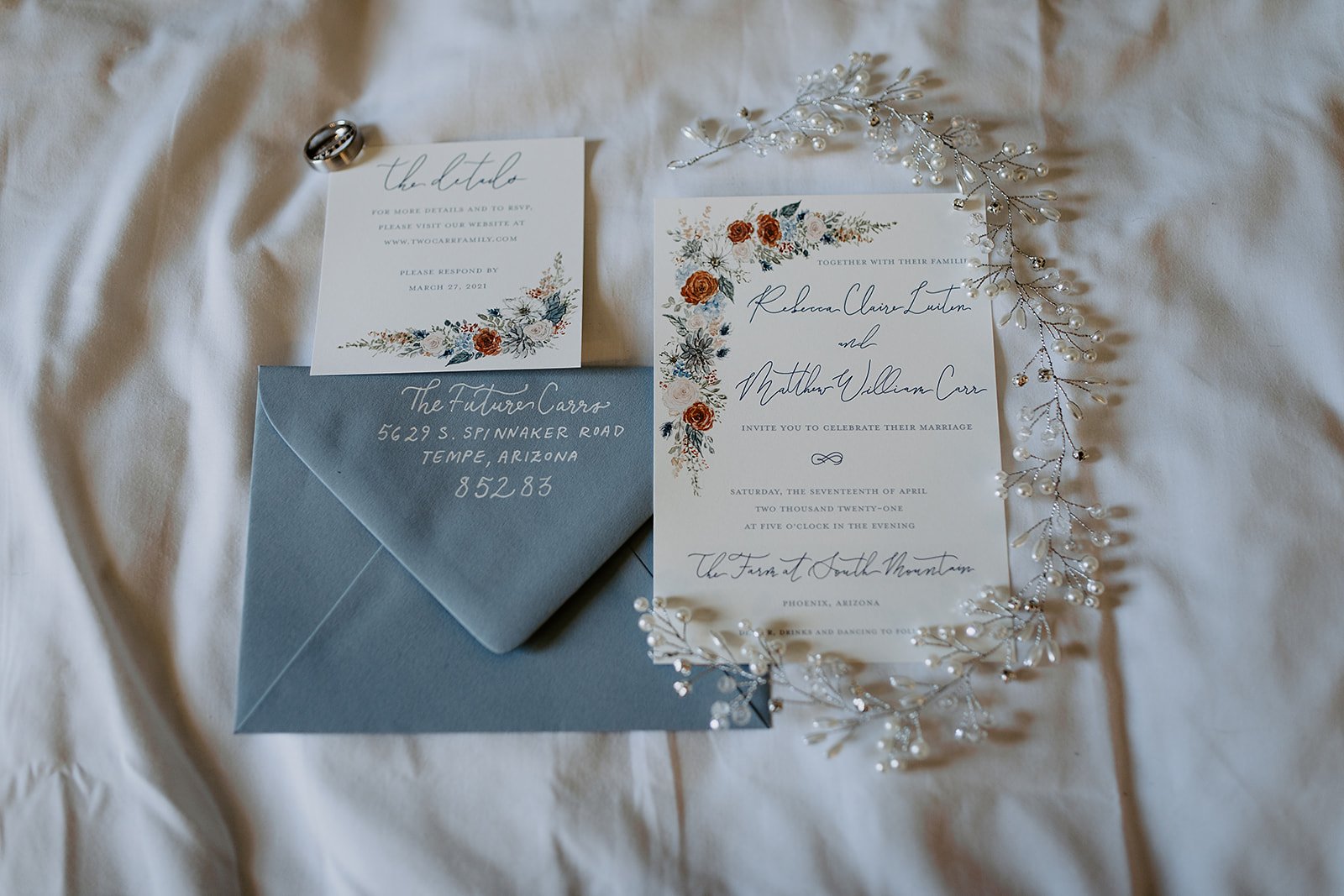Photographer | Alexandra Loraine Photo
Let’s talk invitations! The invitations are the guests' first impression of your theme, colors, and style. They contain all the vital information guests need to be prepared to celebrate. The invitation suite is extremely customizable; they can be as elaborate or minimal as you desire. With that in mind, there are some elements that are nonnegotiables, while others are up to personal choice and budget. Use the following guideline to design your perfect invitation suite combination.
KEY ELEMENTS
There are three elements that comprise the basic necessities of a wedding invitation, no matter the formality level: the envelope, the invitation, and a method of response. For more casual weddings or a budget-friendly option, all the necessary information can easily be covered with this simple setup. More formal events may opt to include additional inserts for the guests' convenience.
ENVELOPE
The envelope includes the guest's address, return address, postage, and clarifies the invitee. To avoid the invites being returned to sender, make sure to have updated addresses for all your guests. The guest's address should be centered on the front of the envelope, but the return address may be placed on either the front upper left corner or on the center back, just above the fold. Before placing postage, weigh the completed envelopes at the post office; wedding invitations often weigh more than the average letter. This way, the stamps purchased will fully cover the cost of delivery. Lastly, be specific when addressing the invitation to avoid miscommunication about who can attend. For example, if children are not invited, address the envelope to “Jeff and Jenny Johnson” rather than “The Johnsons”. To indicate a plus one, address it to “Scott Smith and Guest”.
INVITATION
The majority of the wedding details will be found on the invitation, such as the hosts, the couple to be married, and the ceremony and reception information. The hosts are usually the parents of the bride and groom, or whoever is paying for the event, including both first and last names. When writing out the bride and groom’s names, it is fine to use just the first name, first and middle names, or the entire legal names. Typically, using the full legal name is considered more formal, so assess which is appropriate for your wedding. The ceremony and reception information includes the date, time, name, and address. If both will take place at the same venue, write “reception to follow”. Optionally, the invitation is where attire can be mentioned.
RESPONSE METHOD
The response method traditionally includes a pre-addressed envelope and postage, RSVPs, food allergies, and meal choices, if applicable. The card and envelope are small and inserted into the large envelope also containing the invitation. The response envelope should be pre-addressed to return to the sender with the appropriate amount of postage. On the RSVP card, the guests will write their names and choose to accept or decline the invitation. Additionally, they can share any food allergies and, if a plated meal will be served, select a choice for dinner. In recent years, it is popular to forgo the physical response card and opt for the online alternative. Using a wedding website service, set up your guest list RSVPs and include the link on the invitation or as a separate card. Some find the online option advantageous as it is free, prevents the response cards from being lost, and provides easy tracking of attendance, allergies, and meal choices.
OPTIONAL INSERTS
Now that the basics are covered, let’s talk about the optional pieces: inner envelope, invitation wrapper, ceremony directions, reception card, accommodations, and weekend events. While none of these elements are necessary, they may be included for a few reasons, such as level of formality, aesthetics, providing additional information, and resources for out-of-town guests.
INNER ENVELOPE
While the outer envelope is likely plain, the inner envelope will be on theme with the invitation. When using the inner envelope, there is no need to write the guest’s address again, but it is recommended to reiterate the names of those specifically invited. The inner envelope holds the invitation and all inserts neatly together, while the outer envelope protects the beautiful stationery.
INVITATION WRAPPER
The invitation wrapper holds no information; it is simply the cherry on top of the invitation suite. The wrapper is usually a ribbon or paper that secures the invitation and inserts together. There are many ways to get creative with the wrapper design, like adding a wax seal, dried flowers, or a jewel to really impress your guests.
CEREMONY DIRECTIONS
Including a card with directions or a map will be especially helpful for uncommon ceremony locations. If your venue is nearby and has adequate parking, the directions card is unnecessary. However, if the venue is a remote outdoor location, your guests will appreciate the tips on navigation and where to park. Clarifying the location details ahead of time will also prevent a barrage of phone calls on the wedding day and keep everyone on schedule.
RECEPTION DETAILS
The reception details will include the time of cocktail hour, the time of dinner and the menu, and the location if the venue is different from the ceremony. For venues that have a scheduled end time, the card should indicate that as well. Many guests will appreciate knowing the itinerary in advance if you choose to include this card.
ACCOMMODATIONS
Chances are some guests will need to travel to attend the wedding, a thoughtful inclusion is the accommodation card. On this card, present a few choices of hotels near the ceremony and reception locations. It may be wise to select both a budget-friendly and an upscale option. Recommending accommodations close to the venues will make it easy for the out-of-town guests to navigate or grab an uber. If you’re feeling extra, include some restaurants to try as well.
WEEKEND EVENTS
The weekend events card is a perfect addition to the invitation for a destination wedding or if you plan to celebrate all weekend long! Create an event card for each celebration such as welcome drinks, rehearsal dinner, wedding after party, or brunch the following day. Make sure to include the event time, location, dress code, and any other essential details. Add a card for each event a guest is invited to; this will clearly communicate who is expected at each gathering.
Invitations are your first opportunity to showcase the theme to your guests. Take time to customize the invites, your guests will adore the thoughtful details. Start with the basics to make sure the guests have all the necessary information and then add the details. The options for design and inserts are truly endless! For additional guidance, we are here to help. We would love to discuss all things wedding planning, click here to schedule a consultation and get started today.









